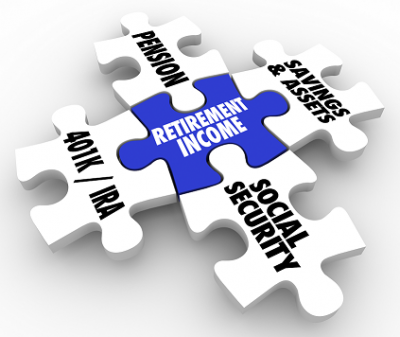In its simplest form, a retirement plan boils down to 2 factors: how much you plan to spend (your expenses) and what sources you can pull from to pay for those expenses (your income). While in your working years, your main source of income may come from one source (your job), many retirees have multiple sources of retirement income.
People age 65 and older tend to receive most of their income from four sources, according to a recent report from the Social Security Administration. Here’s a look at how older Americans are paying for retirement, and how to maximize each source of income.
Social Security
Almost all retirees (84 percent) receive Social Security payments, and many people depend on them. The majority of Americans age 65 and older (52 percent) receive at least half of their income from Social Security, and a quarter receive 90 percent or more of their income in the form of a Social Security check, according to the report.
As has often been written about in this blog, the age you sign up for Social Security plays a big role in how much you will receive each month. If you sign up for benefits before your full retirement age, which is 66 for most baby boomers, you will get a reduced monthly payout. Your monthly check will increase if you delay your start date between ages 66 and 70.
Asset income
The proportion of retirement income being generated by assets, such as interest, dividends, rental income and royalties, has been declining since the 1980s, from 28 percent in 1984 to just 9.7 percent in 2014, according to the report. But retirees with assets tend to be better off in retirement. The median income of retirees with asset income is more than twice that of seniors who don’t have income from investments ($43,476 compared with $17,400).
Retirees with assets must balance the desire to protect their existing savings with the need for continued growth and to keep up with inflation in retirement. The best hedge against inflation is to stay invested in the stock market. Maintaining some exposure, whether it’s 20, 30 or 40 percent in stocks, is going to provide you with at least some growth that is going to help you combat inflation over the long term.
Retirement benefits
Pensions, 401(k)s and other types of workplace retirement benefits provide income to 44 percent of retirees, according to the SSA report, and account for 20.9 percent of the aggregate income for people age 65 and older. A pension that provides steady payments for the rest of your life makes it much easier to pay your bills throughout retirement. However, even annual withdrawals from a 401(k) account can help you to achieve a better standard of living than retirement with only Social Security income would provide. In this case, it becomes important to gradually draw down your account balance in a way that makes it likely to last for the rest of your life.
Continued work
A little over a quarter (29 percent) of retirees receive income from employment in retirement, but the report finds working is becoming an increasingly important component of financial security in retirement. The proportion of all retirement income coming from continued employment has been increasing in recent years from 23.1 percent in 2000 to 32.2 in 2014. However, it’s primarily young retirees who are still working. While almost half (49 percent) of people between ages 65 and 69 receive at least some income from earnings, that drops to 31 percent among people in their early 70s and 19 percent in their late 70s.
